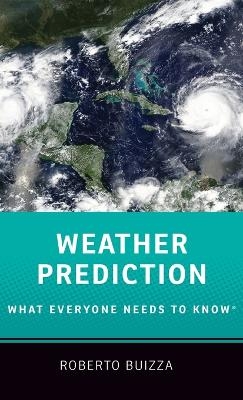
Weather Prediction
Oxford University Press Inc (Verlag)
978-0-19-765213-8 (ISBN)
Some big steps forward in numerical weather prediction have been made in the past 40 years, thanks to advances in four key areas: the way we observe the Earth, the scientific understanding of the phenomena, advances in high-performance computing (that have allowed the use of increasingly complex models), and improved modelling techniques. Today we are capable of predicting extreme events such as hurricanes and extra-tropical windstorms very accurately up to 7 to 10 days ahead. We can predict the most likely path and intensity of storms before they hit a community, estimate the confidence level of the forecast, and can give very valuable indications of their probable impact. Larger-scale phenomena that affect entire countries, such as heat or cold waves, periods with extremely high or low temperatures lasting for days, can be forecast up to 2-to-3 weeks before the events occur. Phenomena that affect a big portion of the oceans or of a continent and that evolve slowly, such as the warming of the sea-surface temperature in the Pacific Ocean when an El Nino event occurs, can be predicted months ahead, and in some cases even longer.
Weather Prediction: What Everyone Needs to Know® discusses some of the key topics linked to weather prediction and explains how we got here. It discusses questions that are often asked, such as: how are weather forecasts generated? How complex are the models used in numerical weather prediction, and how to solve them? Was this event predictable? Why was this forecast wrong? How did you manage to predict this hurricane path 10 days before the event? Will weather forecast continue to improve, or is there a predictability limit?
Roberto Buizza is Professor in Physics at Scuola Superiore Sant'Anna, and Honorary Research Fellow at Imperial College Grantham Institute for Climate Change. He has a degree in physics, a PhD in mathematics, and a master's in business administration. From 1991 to 2018 he worked at the European Centre for Medium-Range Weather Forecasts, where he was a key developer of its prediction systems and served as Head of the Predictability Division and Lead Scientist.
Preface
1 Weather And Climate
1.1 What Is The Key Difference Between Weather And Climate?
1.2 Do Weather And Climate Vary Spatially And Temporally?
1.3 Is There A Clear Separation Between Weather And Climate?
1.4 Is Weather Affected By All (Small-And-Fast And Large-And-Slow) Phenomena?
1.5 Which Coordinate System Is Used To Study Atmospheric And Oceanic Motions?
1.6 What Are The Key Weather Variables?
1.7 Why Does Weather Change?
1.8 How Are Motions In The Atmosphere Generated?
1.9 Key Points Discussed In Chapter One 'Weather And Climate'
2 The Earth System
2.1 What Does 'Earth System' Mean In Numerical Weather Prediction?
2.2 What Is An Accurate And Skilful Forecast?
2.3 What Are The Key Building Blocks Of An Earth System Model?
2.4 What Are The Key Processes Simulated By An Earth System Model?
2.5 How Is Heat Transported And Exchanged In The Earth System?
2.6 Where Does The Energy That Drives The Earth Climate Come From?
2.7 What Are The Key Similarities And Differences Of The Atmosphere And The Ocean?
2.8 Key Points Discussed In Chapter Two 'The Earth-System'
3 Observing The Earth System
3.1 Why Do We Need Observations?
3.2 What Are The Key Observation Types?
3.3 Are Observations Affected By Errors?
3.4 How Do Observation Information And Errors Propagate?
3.5 Did Covid Affect Weather Forecast Quality?
3.6 How Do We Observe The State Of The Atmosphere Using Satellites?
3.7 Do We Have Enough Observations To Determine The State Of The Earth-System?
3.8 Is It Important To Observe The Whole Atmosphere?
3.9 Key Points Discussed In Chapter Three 'Observing The Earth System'
4 Modelling The Earth System
4.1 From Where Should We Start To Model The Earth System?
4.2 What Are The State Variables Of A System?
4.3 How Many Variables Define The State Of The Whole Earth System?
4.4 What Is An Equation?
4.5 What Are Analytical And Numerical Solutions Of An Equation?
4.6 How Do We Deduce The Equations Used To Predict The Weather And The Climate?
4.7 What Is An Example Of A Set Of Equations That Can Predict The Weather?
4.8 How Do We Solve The Primitive Equations?
4.9 What Is The Difference Between A Prognostic And A Diagnostic Equation?
4.10 Can We Use Simple Models To Understand The Behaviour Of Complex Systems?
4.11 Key Points Discussed In Chapter Four 'Modelling The Earth System'
5 Numerical Weather Prediction
5.1 How Do We Solve Numerically The Primitive Equations?
5.2 What Are The Key Steps Involved In Operational Weather Prediction?
5.3 How Do We Determine The Initial Conditions?
5.4 What Is Data Assimilation?
5.5 Do We Need A Super-Computer For Numerical Weather Prediction?
5.6 Do We Need An Earth-System Model To Predict The Weather?
5.7 What Are The Key Differences Between A Global And A Limited-Area Model?
5.8 How Can We Assess Whether A Model Is Realistic And Accurate?
5.9 How Much Data Is Involved In Weather Prediction?
5.10 Key Points Discussed In Chapter Five 'Numerical Weather Prediction'
6 Chaos And Weather Prediction
6.1 What Is A Chaotic System?
6.2 What Is The Lorenz' 3-Dimensional Model?
6.3 What Is The 'Butterfly Effect'?
6.4 What Are The Sources Of Forecast Error?
6.5 How Can We Reduce Initial Condition Uncertainties?
6.6 How Can We Reduce Model Uncertainties?
6.7 How Do We Measure Forecast Errors?
6.8 What Is An Ensemble?
6.9 Are Ensemble Forecasts More Valuable Than Single Ones?
6.10 Key Points Discussed In Chapter Six 'Chaos And Weather Prediction'
7 Dealing With Uncertainties And Probabilistic Forecasting
7.1 How Do We Build An 'Accurate And Reliable' Ensemble?
7.2 What Is A Probabilistic Forecast?
7.3 How Can We Communicate Forecast Uncertainty?
7.4 How Can We Take Decisions Using Probabilistic Forecasts?
7.5 What Is A Scenario Forecast?
7.6 What Is A Cluster Analysis?
7.7 How Do We Measure The Accuracy And Reliability Of A Probabilistic Forecast?
7.8 What Are Reforecasts And Reanalyses?
7.9 Why Are Reanalyses And Reforecasts Useful?
7.10 Key Points Discussed In Chapter Seven 'Dealing With Uncertainties And Probabilistic Forecasting'
8 The Forecast Skill Horizon
8.1 Are Weather Forecasts More Accurate And Reliable Today Than In The Past?
8.2 How Did We Succeed To Improve The Accuracy And Reliability Of Weather Forecasts?
8.3 Can We Visualize In A Single Diagram Our Prediction Capabilities?
8.4 Why Does The Forecast Skill Depend On The Phenomena We Are Trying To Predict?
8.5 Are Extreme Events More Difficult To Predict Than The 'Normal' Weather?
8.6 What Is The Minimum Spatial Scale That A Model Can Simulate Realistically?
8.7 What Is The Minimum Spatial Scale Properly Resolved In Data Assimilation?
8.8 How Can We Further Extend Predictability?
8.9 Key Points Discussed In Chapter Eight 'The Forecast Skill Horizon'
9 Climate Change And Numerical Weather Prediction
9.1 Why Should We Talk About Climate Change In This Book?
9.2 What Is The Greenhouse Effect?
9.3 What Is The State Of The Climate?
9.4 How Much Greenhouse Gases Do We Emit In The Atmosphere?
9.5 Is There A Link Between Greenhouse Gas Emissions And Average Global Warming?
9.6 Are We Responsible For Climate Change?
9.7 What Are The Key Sources Of Uncertainty Affecting Climate Predictions?
9.8 What Do We Mean With 'Initial Value' And 'Boundary Condition' Problems?
9.9 Has Climate Change Impacted Weather Prediction?
9.10 Has Numerical Weather Prediction Helped Understanding Climate Change?
9.11 Which Aspects Of The Future Climate Can We Predict?
9.12 Key Points Discussed In Chapter Nine 'Climate Change And Numerical Weather Prediction'
10 A Look Into The Future
10.1 What Are The Focus Areas Of Research In Numerical Weather Prediction?
10.2 What Is An Earth Digital Twin?
10.3 Will We Be Able To Continue To Improve The Quality Of Weather Forecasts?
10.4 Will We Ever Be Able To Issue A 'Perfect' Forecast?
10.5 In 2050, Will We Be Able To Predict The Local Weather Of The Next Season?
10.6 Can Artificial Intelligence Lead To Improve Predictions?
10.7 What Is An 'Environmental Prediction Model'?
10.8 Is Weather Prediction Evolving Into Environmental Prediction?
10.9 As Global Models Keep Increasing Resolution, Will We Still Use Limited-Area Model?
10.10 Would A Future Operational Suite Look Very Different From Today's One?
10.11 Key Points Discussed In Section 10 'A Look Into The Future'
Essential Glossary
Further Reading
Useful Links
The Author
| Erscheinungsdatum | 07.12.2023 |
|---|---|
| Reihe/Serie | WHAT EVERYONE NEEDS TO KNOW |
| Zusatzinfo | 60 |
| Verlagsort | New York |
| Sprache | englisch |
| Maße | 210 x 140 mm |
| Gewicht | 445 g |
| Themenwelt | Sachbuch/Ratgeber ► Natur / Technik ► Natur / Ökologie |
| Naturwissenschaften ► Geowissenschaften ► Meteorologie / Klimatologie | |
| Naturwissenschaften ► Physik / Astronomie ► Angewandte Physik | |
| Technik ► Umwelttechnik / Biotechnologie | |
| ISBN-10 | 0-19-765213-1 / 0197652131 |
| ISBN-13 | 978-0-19-765213-8 / 9780197652138 |
| Zustand | Neuware |
| Haben Sie eine Frage zum Produkt? |
aus dem Bereich


